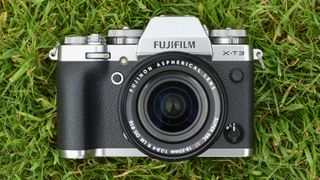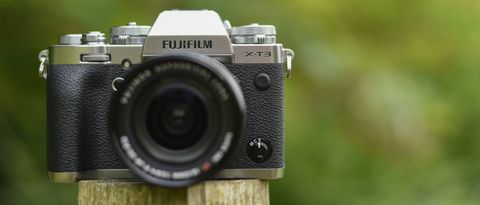TechRadar Verdict
The Fujifilm X-T3 is a solidly built camera that benefits from an extensive refresh of the X-T feature set. With a sound new sensor, upgraded autofocus, stronger video capabilities than before and some useful new features, it's versatile enough to appeal to both existing Fujifilm users and curious DSLR owners after something fresh.
Pros
- +
Excellent build quality
- +
Great new X-Trans sensor with very good noise control
- +
Fast autofocus system, with strong tracking
- +
Great response overall
Cons
- -
Noticeable viewfinder fringing
- -
Post-capture raw processing could be better
- -
EV compensation dial easy to knock
- -
Minor handling issues
Why you can trust TechRadar
Fujifilm has now crafted a number of camera lines for the more discerning photographer, from compacts you can slip into your pocket to interchangeable-lens cameras bolstered by an ever-growing range optics and accessories.
In contrast to its more rangefinder-esque X-Pro line, the X-T series has traditionally been focused around DSLR-type design and operation, with a more defined grip and dual command dials, together with a centrally positioned viewfinder. The new Fujifilm X-T3 appears every bit as handsome as its X-T1 and X-T2 forebears, but it arrives with a considerably stronger feature set than before.
With an APS-C sensor and a four-figure asking price, it occupies the more senior end of the enthusiast camera market, with a particularly broad set of competitors to fight against. With a good helping of fresh technology on board, however, there's a great deal to get excited about, whether you're an existing X Series user or not.
Features
- 26.1MP back-illuminated sensor
- 4K video to 60p (4:2:0 10-bit internal)
- 11fps burst shooting (up to 20fps with electronic shutter)
The X-T3's sensor is new, a fourth-generation X-Trans CMOS sensor with a back-illuminated design. Fujifilm claims that this should better support a lens with a maximum aperture of f/1, the first example of which will be the XF 33mm f/1.0 R WR that’s due for release in 2020.
The new sensor also lowers the native base sensitivity from ISO200 on previous models to ISO160. This move will also no doubt be welcomed by wide-aperture lens users, as it makes it easier to use such lenses in brighter conditions when you don’t have an ND filter to hand.
Fujifilm has also blessed the X-T3 with a fresh processing engine, the X-Processor 4, and this appears to be behind many of the camera’s changes, including a reduction in start up time – now down to 0.3sec – and a shutter lag interval of 0.045sec.
Sensor: 26.1MP back-illuminated X-Trans CMOS 4 sensor
Lens mount: Fujifilm X mount
Screen: 3-inch three-way-tilt touchscreen, 1.04 million dots
Burst shooting: 11fps (20fps with electronic shutter)
Autofocus: 425-point AF
Video: 4K
Connectivity: Bluetooth and Wi-Fi
Battery life: 390 shots (EVF)
Weight: 539g with battery and memory card
In addition to 11fps burst shooting with the mechanical shutter – which, on the X-T2 is only possible through the Vertical Power Booster – and 20fps with the electronic shutter, the camera can be placed into a Sports Finder mode, which applies a 1.25x crop to the frame and outputs images at 16.6MP, while boosting burst speed to 30fps. Impressively, Fujifilm claims the camera will continue to auto-expose and autofocus during the burst, with no blackout between frames.
While the X-T3 doesn’t debut any new Film Simulation modes as such, there have been a few changes to the general offering. The Color Chrome option, which first surfaced in the GFX 50S has made its way here, and this is designed for highly saturated subjects whose details may otherwise fail to record well (such as vibrant flowers).

There are also new Cool Black and Warm Black toning options on hand when recording images on either the Monochrome or ACROS settings, which apply blue and sepia tints respectively to images. These mimic the similar kinds of effects that would traditionally be achieved through different developers in the film era, and they can be applied in nine separate increments in either direction, for either slight or pronounced effects.
The above options join the existing 11 Film Simulation settings that have 16 possible variations when the yellow, red and green colour filters for the Monochrome and ACROS options are taken into account.
The X-T2's video specs were already more than credible, but things have moved on further still here with the X-T3
Wi-Fi and Bluetooth are on board, as it a USB Type C port that can be used to charge the battery while it's inside the camera. The 390-shot frame rate per charge (when using the EVF) represents a 60 frame increase from the X-T2, which is still behind DSLRs of the same level but ahead of many other mirrorless models. Dual card slots, both of which support SDHC and SDXC cards up to the UHS-II standard, are located at the side of the body through their own door.
The X-T2's video specs were already more than credible, but things have moved on further still here with the X-T3. The camera is the only current APS-C-based mirrorless camera that can capture 4K video at 60fps internally with 4:2:0 10bit output, with an F-Log shooting profile able to be selected and both headphone and microphone ports on the side of the body. A firmware update that will make the camera compatible with Hybrid Log Gamma is also promised later this year.

